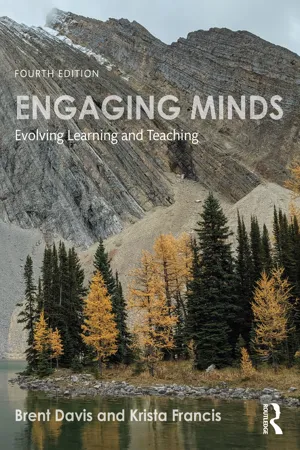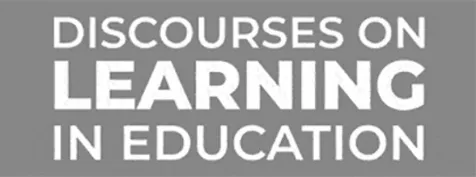
- 262 pages
- English
- ePUB (mobile friendly)
- Available on iOS & Android
About this book
Engaging Minds: Evolving Learning and Teaching explores the diverse beliefs and practices that define the current landscape of formal education. The revised, updated, and expanded fourth edition of this groundbreaking introduction to current interdisciplinary studies of teaching and teacher education is structured around five prominent "frames" of formal education, together offering an overview of the historical and conceptual influences on educational practice:
- Early Formal Education – likely emerged alongside the creation of origin myths and the invention of symbol-based writing systems, presenting needs for individuals charged with communicating, interpreting, and maintaining such knowledge;
- Standardized Education – began to unfold in the 1600s, when public education was invented as a response to the cultural convulsions of industrialization, urbanization, and imperialism;
- Authentic Education – rose to prominence over the last century as researchers began to untangle the complexity of human cognition;
- Democratic Citizenship Education – fuelled by civil rights movements of the 1960s, with the realization that schools often contribute to (or at least help to perpetuate) inequities and injustices;
- Systemic Sustainability Education – an emerging trend, as schools and other cultural institutions find themselves out of step with the transition from a mechanization-focused industrialized society to an ecologically-minded and information-based society.
These frames serve as the foci of the five chapters of the book, each with three sections that deal, respectively, with history, epistemology, and pedagogy within the frame. Richly illustrated and designed, additional pedagogical features include multiple strategies to highlight and distinguish important vocabulary in the text, as well as suggestions for delving deeper into a given topic.
The fourth edition is also complemented by an online resource, learningdiscourses.com, that provides analyses of more than two thousand discourses on learning in education – including summaries and critiques, along with details on their authorship, their imagery, and their associated discourses.
Frequently asked questions
- Essential is ideal for learners and professionals who enjoy exploring a wide range of subjects. Access the Essential Library with 800,000+ trusted titles and best-sellers across business, personal growth, and the humanities. Includes unlimited reading time and Standard Read Aloud voice.
- Complete: Perfect for advanced learners and researchers needing full, unrestricted access. Unlock 1.4M+ books across hundreds of subjects, including academic and specialized titles. The Complete Plan also includes advanced features like Premium Read Aloud and Research Assistant.
Please note we cannot support devices running on iOS 13 and Android 7 or earlier. Learn more about using the app.
Information

FRAME 1 • early formal education
“Modern schooling” is only a few centuries old, but most of its defining features have ancient roots. Some of their influences span traditions that reach back millennia, including models of education that are based on notions of restoring natural orders, recovering veiled knowledge, and retracing sacred paths.
1.1 • The context ...
1.2 • On knowledge and learning ...
1.3 • On teaching ...


§1.1 The Emergence of Early Formal Education
| ADMONISH | DIRECT ATTENTION TO | GIVE INSTRUCTION | INFILTRATE | PROFESS |
| ADVISE | DISCIPLINE | GIVE NEW IDEAS | INFIX | PRIME |
| BEAT INTO | DISSEMINATE | GIVE THE FACTS | INFORM | PUT IN THE WAY OF |
| BRAINWASH | DRAW IN | GRAFT | INFUSE | PUT UP TO |
| BREAK | DRAW OUT | GROUND | INGRAFT | QUALIFY |
| BREAK IN | DRILL | GUIDE | INITIATE | READ A LESSON |
| BREED | EDIFY | HABITUATE | INOCULATE | REAR |
| BRIEF | EDUCATE | HOLD FORTH | INSTILL | SCHOOL |
| BRING FORWARD | ENLARGE THE MIND | ILLUSTRATE | INSTRUCT | SERMONIZE |
| BRING UP | ENLIGHTEN | IMBUE | INTERPRET | SET RIGHT |
| BRING UP TO | EXERCISE | IMPART | INURE | SHAPE |
| CATECHIZE | EXPLAIN | IMPLANT | LECTURE | SHARPEN |
| COACH | EXPOUND | IMPREGNATE | MORALIZE | SHARPEN THE WITS |
| COMMUNICATE | FAMILIARIZE WITH | IMPRESS UPON THE MIND | NURTURE | SHOW |
| CONVERT | FORM | IMPRESS UPON MEMORY | OPEN EYES | SHOW THE ROPES |
| CONVINCE | GIVE A DISCOURSE | IMPROVE | POLISH UP | SOW THE SEEDS OF |
| CRAM | GIVE A LECTURE | IMPROVE MIND | POUND INTO | TAKE IN HAND |
| DEMONSTRATE | GIVE A LESSON | INCEPT | PRACTICE | TAME |
| DEVELOP | GIVE A SERMON | INCULCATE | PREACH | TRAIN |
| DIRECT | GIVE AN IDEA OF | INDOCTRINATE | PREPARE | TUTOR |



- Early Formal Education: The “modern school” dates back only a few centuries, but most of its defining structures, practices, and subject matters have ancient roots – across almost all of which teaching was seen mainly in terms of helping individuals understand their place in the universe.
- Standardized Education: Public education, as it is popularly understood, really only began in the 1600s and 1700s. It was invented as a response to such cultural convulsions as industrialization, urbanization, and capitalism. Teaching came to focus on facts and skills, and it was modeled after working on a factory line.
- Authentic Education: Over the last century, researchers began to untangle the complexity of human cognition. helping educators to realize the inadequacies of popular beliefs about learning. Models of teaching arose that are less directive and more attentive to individuals.
- Democratic Citizenship Education: Prompted by civil rights movements of the 1960s, it became apparent that schools often contribute to (or at least help to perpetuate) inequities and injustices. Teaching came to be seen as a means to address inequalities and suppressions through raising awarenesses.
- Systemic Sustainability Education: Other built-in biases of formal education have been exposed over recent decades, including a human-centered myopia and widespread ignorances of non-modern and non-
The invention of teaching
Table of contents
- Cover Page
- Half-Title Page
- Title Page
- Copyright Page
- Table of Contents
- Acknowledgments
- Overviews
- Frame 1 Eearly formal education
- Frame 2 Standardized education
- Frame 3 Authentic education
- Frame 4 Democratic citizenship education
- Frame 5 •Systemic sustainability education
- Discourses on Learning in Education
- Index